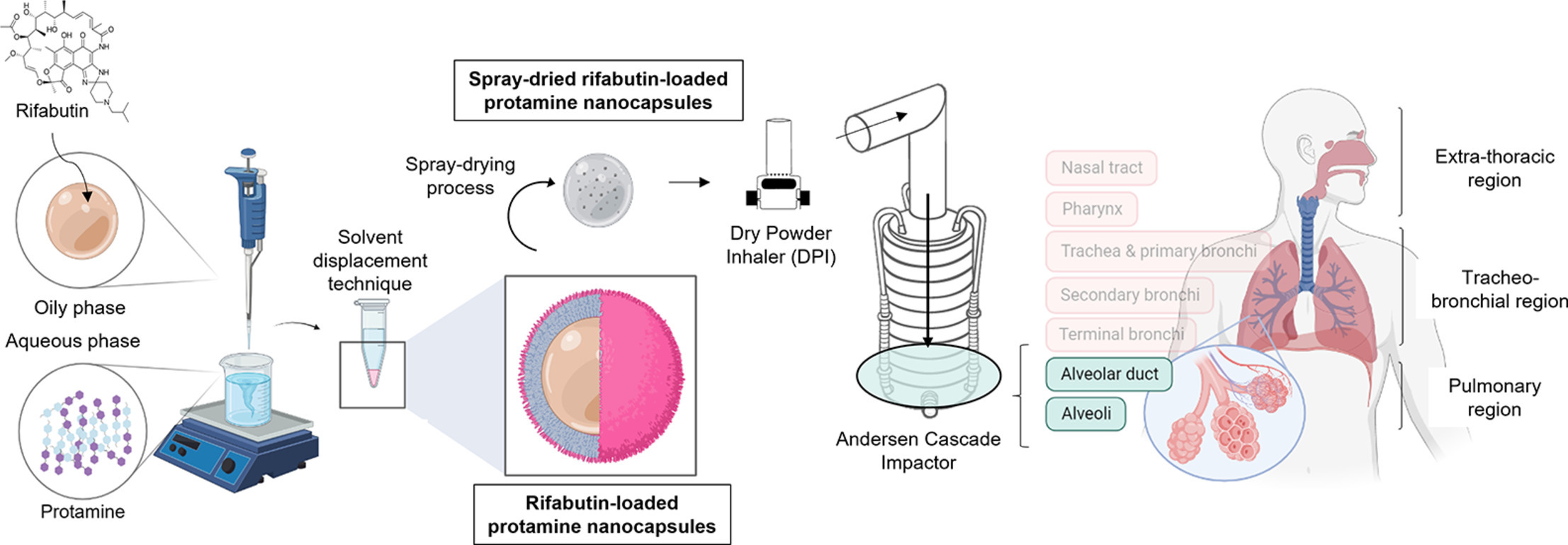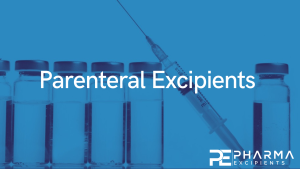A ready-to-use dry powder formulation based on protamine nanocarriers for pulmonary drug delivery

The use of oral antibiotic therapy for the treatment of respiratory diseases such as tuberculosis has promoted the appearance of side effects as well as resistance to these treatments. The low solubility, high metabolism, and degradation of drugs such as rifabutin, have led to the use of combined and prolonged therapies, which difficult patient compliance. In this work, we develop inhalable formulations from biomaterials such as protamine to improve the therapeutic effect. Rifabutin-loaded protamine nanocapsules (NCs) were prepared by solvent displacement method and were physico-chemically characterized and evaluated for their dissolution, permeability, stability, cytotoxicity, hemocompatibility, internalization, and aerodynamic characteristics after a spray-drying procedure.
Protamine NCs presented a size of around 200 nm, positive surface charge, and drug association up to 54%. They were stable as suspension under storage, as well as in biological media and as a dry powder after lyophilization in the presence of mannitol. Nanocapsules showed a good safety profile and cellular uptake with no tolerogenic effect on macrophages and showed good compatibility with red blood cells. Moreover, the aerodynamic evaluation showed a fine particle fraction deposition up to 30% and a mass median aerodynamic diameter of about 5 µm, suitable for the pulmonary delivery of therapeutics.
Download the full article as PDF here A ready-to-use dry powder formulation based on protamine nanocarriers for pulmonary drug delivery
or read it here
Materials
Rifabutin was acquired from Chemos GmbH (Germany). Low molecular weight protamine sulphate (5 kDa) was purchased from Yuki Gosei Kogyo, Ltd (Japan). Polyethylene glycol stearate 40 (PEGst 40) was provided by Croda Chemicals Europe Ltd. (United Kingdom) and sodium glycocholate (SGC) was purchased from Dextra laboratories Ltd. (United Kingdom). Caprylic/capric/succinic triglyceride (Miglyol® 812) was obtained from IOI Oleo GmbH (Germany). D-Mannitol was obtained from Molar Chemical KFT. 3-(4,5-dimethyl-2-thiazolyl)-2,5-diphenyl-2H-tetrazolium bromide (MTT) and 4,6-diamidino-2-phenylindole (DAPI) dye were purchased from Sigma-Aldrich (St. Louis, MO, USA). 1,1′-Dioctadecyl-3,3,3′,3′-tetramethylindodicarbocyanine, 4-chlorobenzenesulfonate salt (DiD) was provided by Thermo Fisher Scientific (USA). Ficoll-Paque™ PLUS was obtained from GE Healthcare Bio-Science AB, (Sweden), Medium Roswell Park Memorial Institute (RPMI-1640), and Dulbecco’s Modified Eagle’s Medium (DMEM) were obtained from GIBCO® (Thermo Fisher Scientific, Spain). Granulocyte-macrophage colony-stimulating factor (GM-CSF) was obtained from Tonbo Biosciences (San Diego, CA, USA). Fetal Bovine Serum (FBS), and PSG (Penicillin-Streptomycin-Glutamine) were provided by Sigma Aldrich. A549 human alveolar lung carcinoma cell line and Raw 264.7 cell line were obtained from ATCC (Manassas, VA, USA). Sodium chloride (NaCl), sodium hydrogen carbonate (NaHCO3), glycine (C₂H₅NO₂), calcium chloride dihydrate (CaCl2), sulfuric acid (H2SO4) and sodium phosphate hydrated (NaH2PO4 H2O) were purchased from Sigma Aldrich (St. Louis, MO, USA), Trifluoroacetic acid was obtained from Merck Schuchardt OHG (Germany). All other reagents were of analytical grade and were used without further purification.
Sandra Robla, Rubén Varela Calviño, Rita Ambrus, Noemi Csaba, A ready-to-use dry powder formulation based on protamine nanocarriers for pulmonary drug delivery, European Journal of Pharmaceutical Sciences, 2023, 106442, ISSN 0928-0987, https://doi.org/10.1016/j.ejps.2023.106442.
Read more on Excipients for Parenterals here


